Concept of Primate City & Primacy
The concept of primate city and city primacy was developed to focus attention on the relationship in size between the largest city and other cities of a closed urban system. City size distribution refers to the frequency distribution of settlements in different size categories. The observed distributions for urban distributions are compared with the theoretical or empirical model such as Central Place Theory, Hoyt Model or Sector Model, the rank size rule, Primate city concept and the mercantilist model.
The idea of primacy was first introduced by mark Jefferson in 1939. His proposition was that nationalism crystallizes in primate cities which are super eminent in both size and national influence. He assessed the degree of primacy by computing the ratio of the size of the second and third ranking cities to that of the largest one. He found that in the forty-six countries of the world the largest cities were two or three times as large as the next largest city. The ratio of the population of the three largest cities approximated the sequence 100:30:20 ( i.e. the third largest is one-fifth the six of the largest). According to him there are various reasons for a city to exceed its neighbors in size, but once it did so the process became cumulative giving it an impetus to grow and draw away from all other cities in character as well as size. The particular ratio sequence has been later ignored, though the concept of the primate city and primacy is widely used.
Related: Rural-urban continuum and causes of rural-urban continuum

Subsequently some theorist have pointed out that the largest cities often happen to be the capital of the countries in which they are located or are outposts of the colonial past and terms like primate, capital and gateway cities have been used to designate them. Other theorist has viewed primate cities as a component in an arrangement or a system of cities. The assumption of the second group of subsequent theorists implied in their arguments is that primacy is a systematic deviation of the largest center from the rank-size distribution suggested by Zipf in 1941.
Characteristics of primate city
• Most dominant city
• Degree of primacy is 1/α (measured by the size of the 2nd largest city)
• Less developed countries have higher degree of primacy and more developed countries have lower degree of primacy
• Simpler political systems less interference of govt. In economic activities
• Industrial agglomerations
• Rapidly expanding population and high density
• High rate of urbanization
• Recent colonial history
Related: What is Urban Growth
After Jefferson two more studies were done by Fryer (1953) and Murphey (1957). Fryer isolated the million cities of Southeast Asia and analysed their site, morphology, and pattern of growth. Murphey traced the growth of capital cities in Asia, most of which were ports. Only in the 1950s explicit studies were made regarding the phenomenon of urban primacy.
Smith pointed out the difference between two kinds of primacy:
- One in which the first ranking or the largest deviates from a regular distribution of cities (i.e. the rank size or log normal which according to him is a “mature distribution”) by being over large.
- One in which the first ranking or the largest city is much larger than all others which may not conform to a regular rank size pattern. In this case the secondary cities are too small in relation to the rank size distribution. The primate may or may not be too large in relation to that distribution. He called this an “immature distribution” which is likely to be linked to poorly develop urban trade. The immature urban system has to be differentiated from the mature one because the forces producing a overly large city in the two systems are different with different policy and implications.
The mature distributions refer to the system which conforms to the rank-size rule. Rank-size rule is an empirical rule used to describe the city size distribution of many countries and was proposed by Zipf. According to the rule the population of any settlement in an urban system can be determined from
- The population of the largest place in that system.
- The position of the settlement being considered in a rank-ordering of all the settlements in that system.
The ranking is in descending order, 1 denoting the position of the largest settlement. The population of each settlement is defined as the population of the largest divided by the rank of the settlement under consideration. If the largest city in a country contains 1,000,000 people, the second largest contain 500,000, the third largest 333,333 and so on, which produces an inverted –shaped relationship between rank and population.
This curve has the following form:
Pr = P1/r
Where P is the population, r is rank order position and 1 is the rank order position. In logarithmic form log Pr = log P1 – logr.
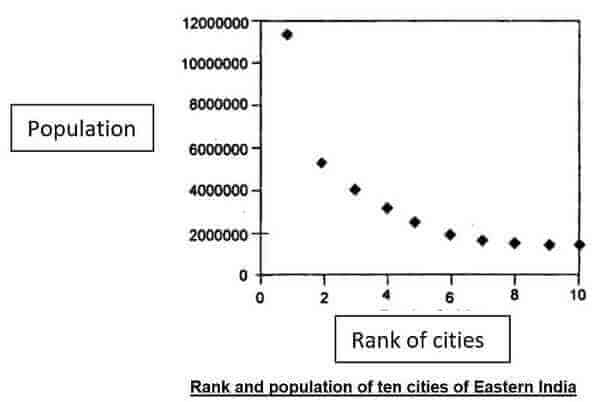
Primate city and Economic development
The role of primate city in economic development was initiated by Hoselitz who argued that urbanization need not always be “generative” of economic growth and cited the case of the colonial cities which were enclaves and contributed to stagnation. According to Lampard in such cities the profits of trade, capital accumulation in agriculture and other primary pursuits were used for urban construction. This resulted in migration of labour and enterprise to larger cities which might otherwise have been invested in some form of manufacturing or processing in the hinterland. Stopler suggested that the cities in the developing countries were parasitic because their physical hinterland is neither their market nor their supply area.
Related: Central Place Theory (CPT) by Walter Christaller (1933)
Examples of Primacy & Rank size rule – Study of Iberian Peninsula, Britain & India
Example from The Iberian Peninsula
The dataset for the towns and cities of Spain and Portugal was derived from Carreras Monfort (1995-1996). The dataset encompasses a total of 107 urban centres, ranging in size from 120 ha―the largest attested town, Emerita Augusta―to only 1.5 ha. This number represents only the known urban perimeters, not the totality of Spanish Roman towns. The urban areas are those enclosed within city-walls, mostly dating to the third century AD. If we first graph our data simply according to number of centres occupying a given area in hectares, we observe that most of the settlements fall into the range 0-19 ha.
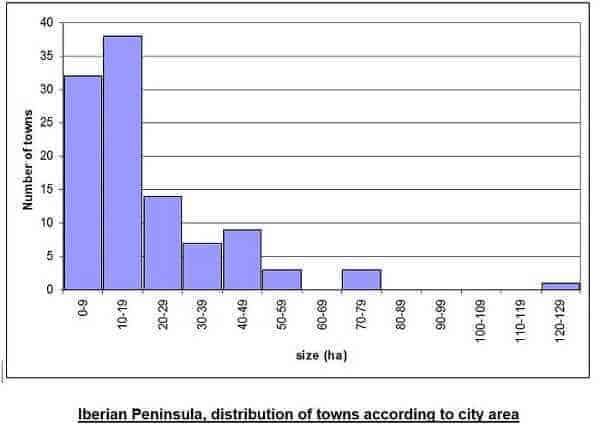
The number of towns in the range 10-19 ha is higher than the 0-9 ha group, and this is contrary to the expectations of settlement hierarchy, where area and number of settlements show an inverse proportion. As we shall see, this fact reflects the partiality of the data.
When we plot all cities at once on logarithmic paper the general trend shows a considerable convex deviation from Zipf’s law. A convex distribution signifies that the settlements below the size of the largest one are larger than the rank-size rule would predict; or, alternatively, that the largest settlement in the examined system is smaller than the rank-size rule would predict.
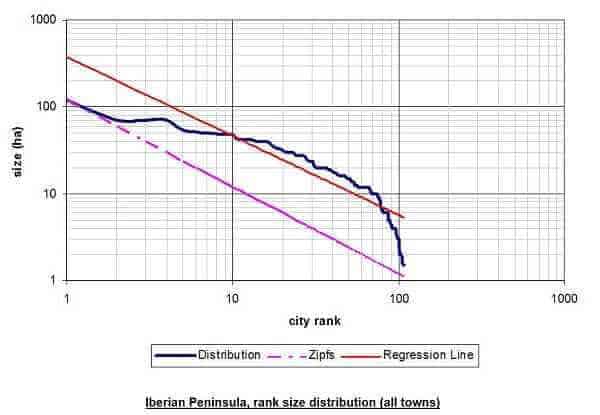
We can also note that at the lower end of the scale, starting approximately at 10 ha and below, the sharp drop in our distribution line in part reflects the many missing settlements whose area we do not know. The area of small towns are, indeed, those more easily ‘missed’, especially when later urban developments obliterated completely the Roman phases, or if the settlement was not fortified.
Example from Britain
The British dataset was derived from Millett (1990). In this case too the sample does not represent the totality of towns existing in Roman Britain. We have the areas for 75 settlements out of 126. The areas listed reflect those enclosed by fortifications, but the dating varies greatly, from the first to the fourth century AD. Graphing the dataset according to rank/size shows that also in this province most of the settlements measure below 20 ha, but with a higher presence of 0-9 ha towns.
the graph on logarithmic paper shows also for Britain a convex deviation from Zipf’s law.
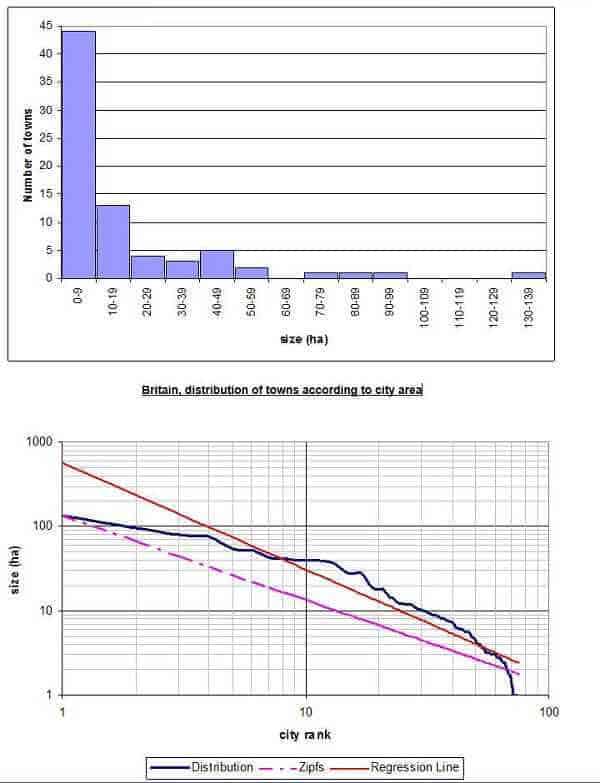
Example from India
It is interesting to note that a similar exercise with the 1971 data of the same area for the class I cities in India has shown a gradual gradation in the size of cities as proposed by Zipfs.
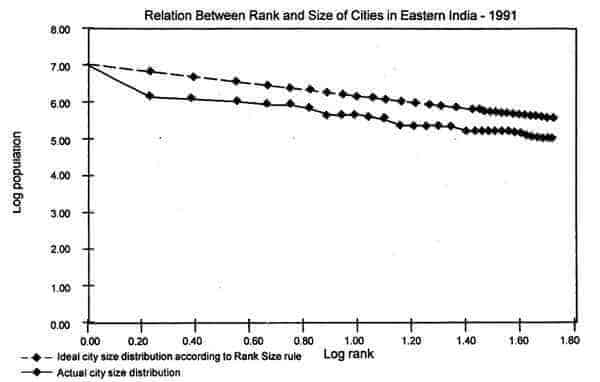
However, the deviation of the actual distribution from that expected in the rank size rule has also been illustrated by the 1971, indicating the primacy of first ranking city. These facts perhaps indicate the following points:
- Primacy of metropolis of Calcutta seems to have remained unchanged between 1971 and 1991.
- By 1991 a stepped hierarchy has gradually emerged in the region as postulated in the model proposed by Christaller though it would be interesting to study the functional differences between the settlements ranking above and below the breaks identified in the 1991 pattern.
Related: Burgess model or concentric zone model
Analysis & Interpretation from Primate City and concept of Primacy
Johnson (1977: 498) stressed the variability in rank-size distribution, which can range from a concave curve (indicator of primate model) to log-normal (Zipf’s law) to convex and pointed out the importance of explaining the factors behind these deviations. An examination of the reasons determining a convex distribution can be found in Johnson 1980. He first examines the hypothesis that if Zipf’s law shows, from the economic point of view, an integrated urban system, then the convexity should be related to the effects of low system integration. This hypothesis is well-tested in the case of the United States from 1750 to 1850, where rank-size convexity and per capita trade volume show an inverse relationship (internal trade is used as indicator of relative system integration).
An explanation for rank-size convex distributions put forward by various analysts has indicated that this type of distribution occurs when the area under examination is located on the periphery of a dendritic settlement system. This is a term used in anthropology to describe ‘a primate settlement system which exhibits decreasing settlement functional size with decreasing distance from the primate center and weak horizontal articulation among settlements at lower levels of the settlements hierarchy. Dendritic systems are often found in countries which were former members of colonial empires’ (Johnson 1980: 241). If the study-area does not contain the core of the dendritic system, we have a case of ‘partitioning’ resulting in a convex distribution.
Sources & References: An Introduction to Development and Regional Planning, Urbanization- UN Habitat, Rank-Size Analysis And The Cities Of Roman Spain And Britain: Some Preliminary Considerations – Annalisa Marzano
Must Read:
- Galactic City Model
- Primate City & Primacy Concept | Relationship between city sizes
- What are ghost towns?
- Satellite City | Meaning, Characteristics, & Examples
- Aerotropolis: Airport Centric Cities
- Counter Urbanisation | Meaning, Factors, Effects and Examples
- City Branding
Tags: Primate City, Primate City Definition, What is Primate City, Primate Cities, Urban Primacy, Primacy Concept, City Primacy, Primate City Rule, Primate City Examples, Law of Primate City, Primate City Model